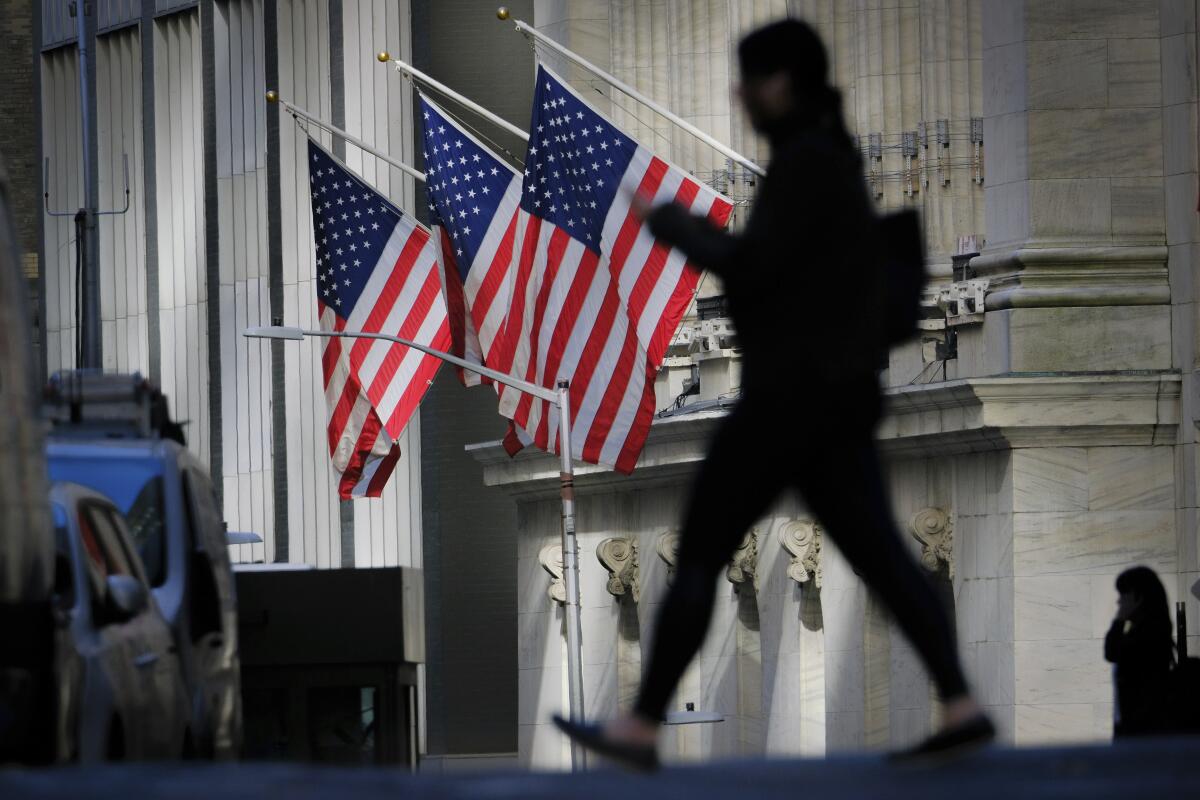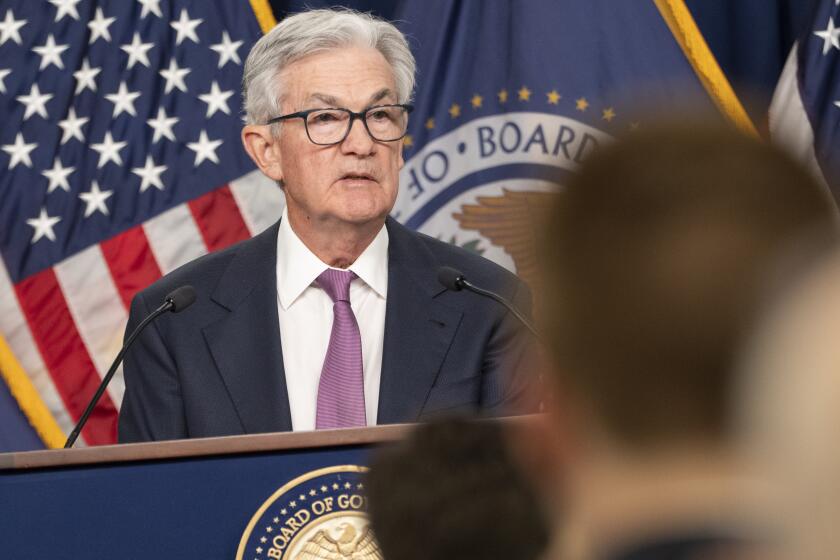Stocks steady themselves after Wall Street’s rout last week

- Share via
Stocks steadied themselves on Monday after Wall Street’s worst week since early December.
The Standard & Poor’s 500 index rose 12.20 points, or 0.3%, to 3,982.24 for just its second gain in the last seven days. The Dow Jones industrial average gained 72.17 points, or 0.2%, to close at 32,889.09, while the Nasdaq composite climbed 72.04 points, or 0.6%, to 11,466.98.
Stocks have struggled in February after a strong start to the year as reports have shown inflation and much of the overall economy are staying more resilient than expected. While the strong economic data calm fears that a recession may be imminent, they also have forced Wall Street to raise its forecasts for how high the Federal Reserve will take interest rates and how long it will keep them there.
High rates can drive down inflation, but they also raise the risk of a recession because they slow the economy. They also hurt prices for stocks and other investments.
The heightened expectations for higher rates have been most evident in the bond market, where yields have shot higher in recent weeks. On Monday, the yield on the 10-year Treasury slunk back a bit and eased some of the pressure on stocks.
The Federal Reserve’s preferred inflation gauge rose last month at its fastest pace since June, which could lead the Fed to keep raising interest rates.
The 10-year Treasury yield dipped to 3.92% from 3.95% late Friday. That yield helps set rates for mortgages and other important loans. The two-year yield, which moves more on expectations for the Fed, slipped to 4.79% from 4.81%. It’s near its highest level since 2007.
Yields eased after a report showed that orders for machinery, aircraft and other long-lasting manufactured goods fell by more than economists had forecast in January.
Economists have been expecting more softness in the economy after the Fed jacked up rates last year at the fastest pace in decades. But reports on the job market, spending by consumers, inflation itself and other gauges have been coming in firmer than expected over the last few weeks.
The fear is that if the economy stays on strong footing, it could feed into upward pressure on inflation. That’s why expectations on Wall Street have swung so hard, from earlier thinking the Fed could soon take it easier on interest rates to now believing it could raise them above 5.25%.
The Fed’s key overnight rate is now in a range of 4.50% to 4.75%, up from virtually zero at the start of last year.
Even Monday’s weaker-than-expected report on durable goods had some underlying strength. After ignoring transportation-related equipment, orders jumped last month to the biggest gain since March. It was much stronger than the drop that economists expected to see.
Nearly all Fed policymakers agreed this month to slow the pace of interest rate increases to a quarter-point, with ‘a few’ supporting a larger hike.
Economies around the world have remained more resilient than feared, with China loosening its business-damaging anti-COVID restrictions and Europe avoiding a worst-case energy crisis. That’s helped give the U.S. economy support, said Sameer Samana, senior global market strategist at Wells Fargo Investment Institute.
He came into this year expecting a recession to hit in the early to middle parts of 2023, which could have encouraged the Fed to cut rates by the end of the year. Given all the strength, though, he now doesn’t expect a recession to hit until the second half of the year. That could encourage the Fed to keep raising rates further as it tries to get inflation down to its 2% goal. It also probably removes the possibility of rate cuts this year.
Even with the worries about rates going higher than expected, the S&P 500 is still holding on to a gain of 3.7% for the year so far, and shoppers are still continuing to spend at stores. Both can add upward pressure on inflation.
“I’ll term it animal spirits, both in markets and consumers,” Samana said. “I think there’s a lot of speculation still going on in markets” with some of the riskiest bonds and stocks rallying in price. “And for consumers, somehow the consumer has brushed it aside and said it’s more difficult for me to consume but I’ll keep doing it.
“We can call it persistence or stubbornness, but we’ve seen it both on the part of consumers and investors. And that’s made the Fed’s job much harder.”
On Wall Street, Union Pacific jumped 10.1% after the railroad announced plans to replace its chief executive later this year. The company has been pressured by a hedge fund with a big ownership stake in it.
Most companies have already reported their results for the last three months of 2022, but a couple of dozen companies in the S&P 500 are still scheduled to report this week.
They may offer a window into how well U.S. households are holding up amid higher interest rates and inflation. Advance Auto Parts, Kroger and Target are some of the companies on the schedule for this week.
Overall, this earnings reporting season has been lackluster. Companies in the S&P 500 are on track to report their first drop in earnings per share from a year earlier since the summer of 2020, according to FactSet.
AP writers Elaine Kurtenbach and Matt Ott contributed to this report.
More to Read
Inside the business of entertainment
The Wide Shot brings you news, analysis and insights on everything from streaming wars to production — and what it all means for the future.
You may occasionally receive promotional content from the Los Angeles Times.












